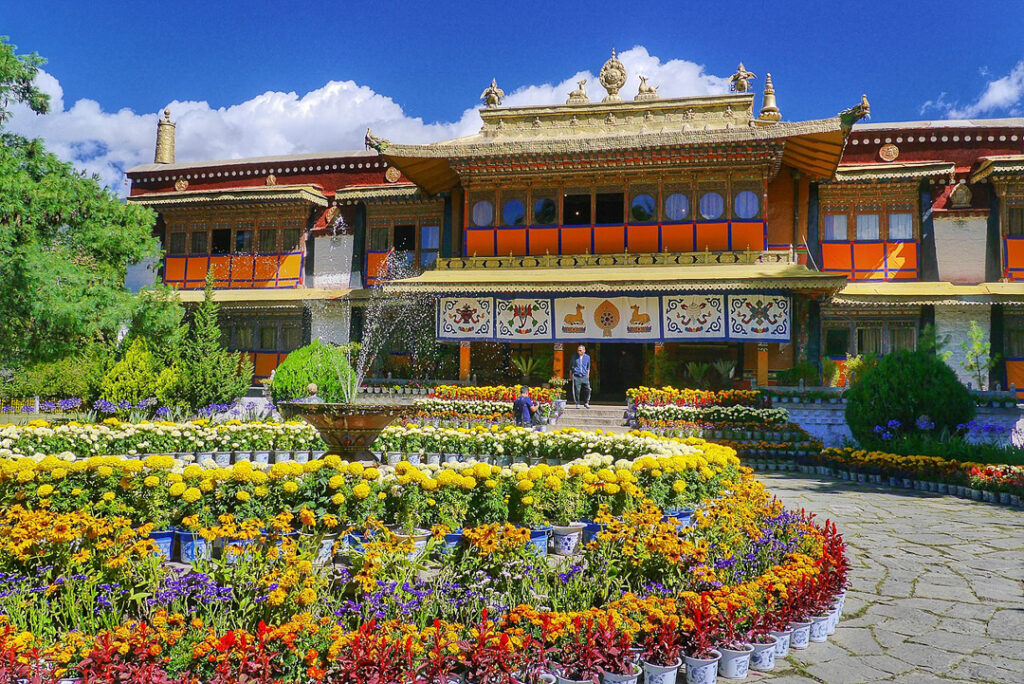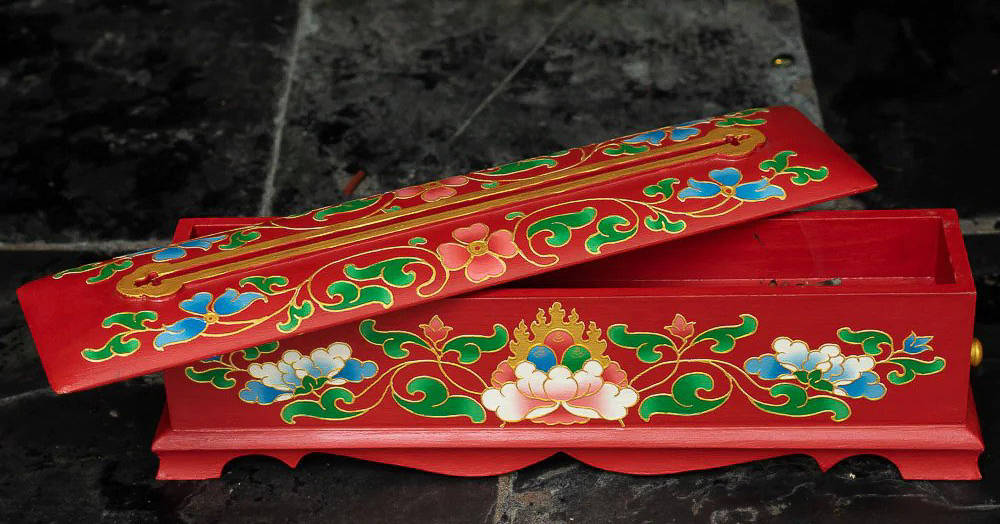Japneeth Keith ventures to little Lhasa, the source of Tibetan incense craft.
Our sense of smell, or olfaction, is a remarkable gift that allows us to traverse the realms of memory and emotion with a single whiff. Fragrances hold a profound power over our senses, evoking nostalgia, joy, or even melancholy, transporting us to distant places and cherished moments. One such revered fragrance is of my journey during family prayers and ceremonies, and the other is of a two-month research project in little Lhasa in India. This fragrance that I bought along with me from Maclodganj echoed in my studio for years, as I purchased a large volume of traditional Tibetan incense for my studio.
Aromatic Offerings in Spiritual Practices
Throughout history, cultures across the world have embraced fragrances for their spiritual, ceremonial, and medicinal significance. In Hinduism, the panchoprachara rituals stand as a beautiful example of devotion to the divine through the senses. As the fragrant smoke of incense gracefully ascends during these rituals, it purifies the atmosphere, creating a sacred space where the soul can commune with the divine in a dance of reverence and love. These aromatic offerings symbolize the dedication of the five senses, from the earthy sandalwood paste representing the element of earth to the delicate flowers symbolizing the element of water, each fragrance carries deep spiritual symbolism.
Panchopachara Puja – A Symphony of Devotion
Panchopachara Puja, with its fivefold offerings, is a simple yet profound form of worship that beckons the senses into a harmonious symphony of devotion. The fragrance of the gandha, the earthy sandalwood paste or incense, represents the element of earth, grounding us in the present moment and connecting us to the richness of the natural world. The flowers, symbolizing beauty and purity, pay homage to the element of water, immersing us in the boundless ocean of divine grace, where each blossom becomes a symbol of life’s delicate beauty. The incense, flickering with the element of fire, connects us to the divine presence, illuminating our path with knowledge and enlightenment. The lamp, radiating the element of air, ignites the flame of wisdom within, dispelling the darkness of ignorance and guiding us towards clarity and understanding. Finally, the food offering, signifying the element of space, represents the essence of hospitality and devotion, nurturing our bodies and souls and reminding us of the interconnectedness of all beings.
The Aromatic Symphony of Tibet
Across the majestic landscapes of Tibet, another symphony of scents unfolds, deeply intertwined with the spiritual practices of the region. Handcrafted Tibetan incense sticks, meticulously prepared using natural ingredients like medicinal herbs, flowers, and woods, hold profound significance in bridging the gap between humans and the spiritual realms. As the captivating scent of incense fills the monasteries and homes, it adds an ethereal dimension to Tibetan practices and way of life, creating an ambience conducive to meditation, prayer, and reflection. What I saw and experienced during my travel was that Tibetans in exile have brought along their culture to India and put roots to practice their traditions wholeheartedly.
Sang Cho – An Ancient Tibetan Ritual
In Tibetan culture, various types of sang offerings are made for specific purposes, each accompanied by a unique blend of fragrances. Smoking or more appropriately known as Sang chö, a purification practice, utilizes incense with purifying qualities like sandalwood or frankincense to remove negative influences from the mind stream and create a more positive environment. Sang gyälpo, a smoke offering made to local spirits and deities, employs incense with protective qualities like juniper or pine to gain their protection and support. Sang dorjé, a smoke offering made to the Buddhas and bodhisattvas, uses incense with wisdom-enhancing qualities like camphor or myrrh to generate merit and invoke their presence in the world. This unique Tibetan ritual, Sang Cho, originates from the ancient Tibetan Bon tradition. In this integral spiritual practice, specific herbs, resins, and medicinal plants are carefully burned to release fragrant smoke. The aroma of Sang Cho is believed to appease deities and spirits, fostering harmony and balance in the environment, and creating a sacred space where humans and divine beings can harmoniously coexist.
The Artistry of Norbulingka: Preserving Tibetan Heritage
At the Norbulingka Institute, nestled amidst the serene beauty of McLeod Ganj, India, Tibetan culture thrives as young Tibetans in exile learn traditional crafts. I was fortunate as a young aspiring designer to have the opportunity to observe the craft masters and students in 2006. Once the permissions were granted to document the craft institute, I was introduced to Master Pemba Dorje. In 1959, Pemba Dorje fled to India following the Tibetan uprising in Lhasa. He settled in Dharamsala and was soon back to work, with the task to build three large statues in the main temple in Dharamsala, the spiritual centre of Tibetans in exile. In the late 70s, he joined a training centre in lower Dharamsala, where he taught metal sculpture, training 20 young boys in a curriculum that was to last 12 years. In 1973, His Holiness the Dalai Lama appointed Pemba Dorje as Tibet’s master statue maker, following a tradition of guilds established by the 7th Dalai Lama and maintained up to 1959.
The Journey of Woodcarving at Norbulingka
When it comes to the art of woodcarving, the Norbulingka Institute stands as a beacon of excellence, preserving the traditional craft and nurturing the talents of young artisans. The process of woodcarving at Norbulingka is steeped in tradition and takes years of training and practice to master. Aspiring woodcarving students undergo rigorous training for three years to hone their craft. The journey begins with learning to draw traditional designs meticulously, as precision and attention to detail are paramount in this art form.
The Exquisite Beauty of Handcrafted Art
Carving starts with transferring the design onto the flat surface of the wood. Using a Tibetan bamboo fret saw, the students carefully cut out holes in the image, setting the stage for the creation of depth and dimension in the final artwork. Armed with their set of chisels, the students proceed to carve the design from both the front and back of the wood, infusing life into the piece as they carve each delicate stroke. The apprentices begin their journey by working with pinewood, a softer and more forgiving material that allows them to learn and refine their skills. As they progress and gain confidence, they move on to teakwood, which presents more challenges due to its density and hardness.
The Flowers and Vines Incense Burner: A Fusion of Art and Spirituality
Within the Norbulingka Institute’s remarkable creations lies the Dharma Collection, a treasure trove of exquisite products that showcase the profound beauty of Tibetan artistry. Among them, the Flowers and Vines Incense Burner stands out as a symbol of craftsmanship, spirituality, and cultural heritage. Handcrafted with precision and love, this incense burner exemplifies the iconic Tibetan motifs, including floral patterns and vines, known for their auspicious symbolism. The creation of the Flowers and Vines Incense Burner involves an intricate process, guided by the expertise passed down through generations of Tibetan artisans. The relief painting technique called “kyumbur” adds texture and depth to the design, elevating the artwork to a three-dimensional masterpiece.
Among the myriad of artistic wonders, the art of crafting wooden incense boxes stands as a testament to the timeless beauty of Tibetan aesthetics. These exquisitely carved boxes become vessels for fragrant offerings, symbolizing devotion, purity, and the dissemination of prayers to the divine realm. The fragrance of the handcrafted Tibetan incense sticks and the artistry of the boxes keep the traditions alive, a testament to the rich cultural heritage of Tibet
Reviving Traditions and Preserving Heritage
Throughout their training, the students also learn fundamental carpentry techniques, enabling them to cut and join pieces of wood with finesse. After completing their apprenticeship, many carving students join the Norbulingka workshop, where they continue to develop their skills and creativity. Though they have mastered the basic designs, creating the exquisitely carved thrones and cabinets that grace the shrine rooms and altars of esteemed homes and monasteries demands even more years of dedication and practice.
The Timeless Harmony of Fragrance and Artistry
As we continue to unveil the aromatic tapestry woven by fragrances, we embrace the legacy of woodcarving and the artistry of the Norbulingka Institute. The harmonious symphony of scents and the intricately carved masterpieces carry us on a timeless journey, where the past, present, and future converge in a celebration of cultural heritage and the beauty of human expression. From the sacred rituals of Panchopachara Puja to the elegant simplicity of handcrafted incense boxes, the fragrances and craftsmanship resonate as a language that unites us all in the tapestry of sensory delight. Through supporting the preservation of traditional arts, we nurture the everlasting connection between fragrance and human experience, ensuring that the beauty and wisdom of ancient traditions continue to enrich our lives and inspire generations to come.
About Japneet Keith
 My heritage is Punjabi. I grew up in Chandigarh with my parents who believed in the teachings of Sikh religion. The foundation of the Sikh culture taught me to always believe in Sikh Congregational prayer (Ardas), the Sikh recites “Sikhan da mann nevan mat uchi.” It implies, may the Khalsa be humble in mind and exalted in understanding, or “May the passions in the hearts of the Sikhs remain calm and their reason flow clear, and may the reason always be guided by the light of God”. This resonates in me wherever I go. A woman follower of the Sikh doctrines is a sardarni. So I believe I am a sardarni in my nature and an ardent lover of my culture and roots. I was born and grew up in Chandigarh. For my further studies, I moved to Ahmedabad, Gujarat to pursue master’s in Design. I have been visiting Australia to work in this culture and it’s only now I can wholeheartedly say this is home as well. I teach pottery, absorb the tactile stories of our journeys, while I explore nature and form in clay and share as much as I can with the people I connect with. I am currently working towards an exchange programme between Indian & Australian communities, artists, and travellers. I work with the studio named RedMug studio pottery in India. Follow @redmugstudiopottery
My heritage is Punjabi. I grew up in Chandigarh with my parents who believed in the teachings of Sikh religion. The foundation of the Sikh culture taught me to always believe in Sikh Congregational prayer (Ardas), the Sikh recites “Sikhan da mann nevan mat uchi.” It implies, may the Khalsa be humble in mind and exalted in understanding, or “May the passions in the hearts of the Sikhs remain calm and their reason flow clear, and may the reason always be guided by the light of God”. This resonates in me wherever I go. A woman follower of the Sikh doctrines is a sardarni. So I believe I am a sardarni in my nature and an ardent lover of my culture and roots. I was born and grew up in Chandigarh. For my further studies, I moved to Ahmedabad, Gujarat to pursue master’s in Design. I have been visiting Australia to work in this culture and it’s only now I can wholeheartedly say this is home as well. I teach pottery, absorb the tactile stories of our journeys, while I explore nature and form in clay and share as much as I can with the people I connect with. I am currently working towards an exchange programme between Indian & Australian communities, artists, and travellers. I work with the studio named RedMug studio pottery in India. Follow @redmugstudiopottery





